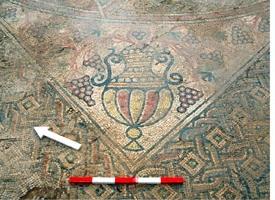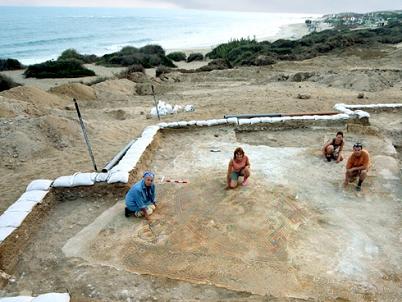The discovery was made as part of excavations on behalf of the Institute of Archeology of Tel Aviv University
A mosaic floor from the 6th century AD was discovered this week, during Yavne-Yam excavations conducted on behalf of the Sonia and Marko Nadler Institute of Archeology of Tel Aviv University and under the direction of Professor Moshe Fisher and Mr. Itamar Taksel from the Department of Archeology and Ancient Near Eastern Civilizations named after Jacob. Alkov, as part of excavations at the site that have been taking place since 1992. Among the many findings discovered so far, there were also the remains of the estate of the Byzantine empress Eudokia who placed it at the disposal of the Georgian bishop Petros the Iberian at the end of the fifth century AD.

On the western side of the area excavated this year, the remains of a villa from the Byzantine period were discovered, with a reception or dining hall decorated with a mosaic floor. The size of the hall is about 7 x 5 m and next to it were entrance rooms and an inner courtyard with a strong plaster floor on which and in which innocent vessels were discovered in situ. The mosaic floor was only partially preserved, but this already indicates both the high quality and the absence of figurative models. At the edges of the overflow there were several frame strips decorated with the braided rope pattern, while the central surface had a spacious medallion divided into several segments by strips of the meander pattern (angular broken line) consisting of red and yellow strips. In the surfaces created by this division there were models of fruit trees and fruit baskets. The four corners formed between the central medallion and the square frame were probably decorated with a vessel for storing wine (amphora) from which vines and clusters of grapes grow. This model was preserved intact in only one corner, while in another corner only its triangular base was preserved. The ephemera that has been preserved is reminiscent of the delicate Roman amphorae, its handles are in the form of volutes (curling lines) and the body is decorated with carving all the way up. The patterns in the mosaic and its design make it possible to date it to the sixth century AD, a date that is fully supported by the ceramics and coins found in the same assemblage.
During the excavations, since 1992, the remains of a settlement from the end of the Iron Age (seventh century BC), the Persian period (sixth-fourth centuries BC), the Hellenistic period, and especially the remains of the destruction caused by the Hasmonean conquest of the settlement (end of the second century BC) AD), the Byzantine period (fifth to seventh centuries AD) and the early Islamic period (eighth to eleventh AD).
In all these periods it is a prosperous settlement that was centered around its port, which was its main source of livelihood and thus being exposed to the Mediterranean world. The many finds throughout all these periods that point to cultural and commercial ties with Egypt, Lebanon, Cyprus, Asia Minor and the Greek islands.
Yavne-Yam served as a port for settlements in the interior of the country, almost non-stop, starting from the Middle Bronze Age (middle of the second millennium BC) until the Middle Ages. Its name was associated with a birch, as noted in literary sources from antiquity, such as the books of the Maccabees, the writings of Pliny the Elder, Josephus, the geographer Ptolemy of Alexandria, ecclesiastical literature and Muslim sources. Of these sources, the essay about the life of Petros Iberi, a bishop of Georgian descent who spent the end of his life in Yavne-Yam around the nineties of the fifth century AD, should be mentioned in particular. This essay allows an extraordinary glimpse into the character of the settlement, its ethnic and religious composition and its importance. The current excavation season does add the archaeological aspect to the situation described there.
Volunteers from Israel and abroad are participating in the excavation, including a delegation from the Academy of the Republic of Georgia. The excavation is a framework for a limited number of students of the "Archaeologist Excavating" course of the Department of Archeology and an educational excavation for two female students from this department.
Prof. Fisher points out that the Yavne-Yam archaeological site is within the scope of a declared national park, but since it is not protected by any control system. "I predict that in a few years there will be no trace of the ancient remains on the site. The Yavne-Yam excavation project is trying to save some of the antiquities, but also to warn about the danger of preserving this site," says Prof. Fisher.


6 תגובות
There is pain in the loss of archaeological finds. This pain is based on our longing to reach the truth and solve the mysteries that are hidden in the past. We think that the disappearance of the findings and their sale to antique dealers will reduce our ability to reach the truth hidden in the past. It may be so and it may not be.
Nevertheless, it is not required to collect all the evidence in the field. Their accumulation and preservation is for collecting and hoarding reasons. If there is a photographed and documented finding, there is no need to store it and present it in order to extract the evidence from it.
At the same time, it is difficult to see the findings disappearing and being looted. I try to reduce my pain of losing the evidence from the past. If all of the above, it still hurts.
First time you dig and have to cover, professor? Does that surprise you? There is no money for archaeology, that's why I am no longer in the field, because I understand that it is better not to reveal than to reveal and leave a breach. If you have complaints, maybe stand up for yourself and keep the mosaic (that's what we did until it was decided to cover it).
To my father - how dare you publish such subversive news?
This is a day of mourning for "Dr." Yachiam Sorek and his friends from the well-known and celebrated faculty of history at the kibbutz seminary, who eat their hats with great appetite and whistle the Hamas anthem from end to beginning. Oh my, what will happen? These findings may call into question the theory they developed that there have always been only feelings here of plastic surgeons and everything beyond that is because of the occupation.
Where the hell are the Revolutionary Guards?
In fact, there are excavations in Palmachim at two sites, a southern and a northern one
When the northern site is "survey" excavations that are always carried out before starting the construction of a project of vacation apartments (resort = high-rise apartments for the rich only and the destruction of the existing nature)
I wish they would find an ancient tomb there with a curse on it and anyone who approaches the place will be cursed (except the diggers and the common people)
Amen
Fence off the place with warning signs "Beware of mines!"
I wonder if excavations under the sea
With so many years of seafaring there must be treasures scattered there
The bottom of the sea is the only place that treasure robbers avoided.